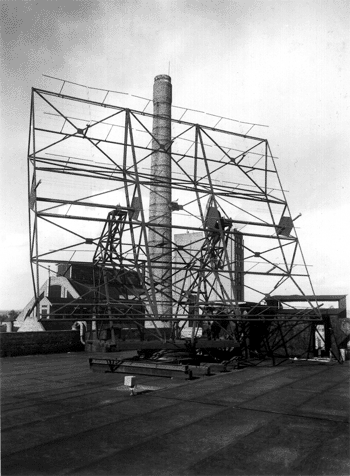
„A Holdat ott láttam elsétálni a torony mögött s azt kérdeztem a felnőttektől: Ha felmásznék a toronyra meg tudnám-é tapogatni a Holdat?”
Bay Zoltán emlékezete a Tungsram Operations Kft. támogatásával jut el a Holdra.
Bay Zoltán: Az élet erősebb
Bay Zoltán volt az első magyar, aki radarhullámokkal “megtapogatta” a Holdat, ahogyan az itt elhelyezett tábla hirdeti. 1946. február 6-án az újpesti Egyesült Izzólámpa és Villamossági Rt., röviden Tungsram, kutatólaboratóriumának csapata bejelentette, hogy sikerült a Holdra irányított radarhullám visszhangját észlelniük. A kutatócsapat vezetője Bay Zoltán volt. Az alkalmazott jelösszegzési eljárás miatt ez a kísérlet kiemelkedő jelentőségű a három héttel korábban, 1946. január 10-én végrehajtott, szintén sikeres amerikai kísérlettel összehasonlítva is. A jelösszegzés kiemelkedő szerepet játszott az emberiségnek a világegyetem megismerésére irányuló törekvésében és egy új tudományág, a radarcsillagászat alapjának megteremtésében. A röviddel korábban véget ért második világháborúban vesztes Magyarországon reményt sugárzott és demonstrálta tudományos kapacitásának képességét.
Bay Zoltán (1900-1992) a Tungsram kutatóintézetének vezetője volt 1936-tól, s 1944-től 1948-ig a vállalat műszaki vezérigazgatói pozícióját is betöltötte. A Tungsram tisztelettel őrzi emlékét kutatóintézeti működése és a második világháború idején tanúsított helytállása miatt. Tudományos eredményein túl a humanista értékek melletti kiállása teszi őt a 20. század egyik inspiráló személyiségévé.
Bay Zoltán 1900-ban Gyulavárin református lelkész fiaként született. Gyermekkori álma volt megérinteni a Holdat, mely a templom tornyától karnyújtási távolságra látszott elhelyezkedni. A középiskolát Debrecenben, egyetemi tanulmányait a Budapesti Tudományegyetemen (ma Eötvös József Tudományegyetem, ELTE) végezte (1923), ahol fizikai doktori címét is szerezte (1926). Ezután Berlinben, a korabeli fizika szellemi központjában folytatott kutatásokat a Physikalisch-Technische Reichsanstaltban és a Friedrich Wilhelm (ma Humboldt) Egyetemen. Ekkori legfontosabb eredménye annak kimutatása volt, hogy a nitrogéngáz akkor aktív, ha szabad nitrogénatomokból áll.
Az akkori magyar oktatási miniszter, Klebesberg Kunó hívta őt haza Németországból. Az elméleti fizika tanszék vezetője lett a szegedi Ferenc József Tudományegyetemen; az ország legfiatalabb professzora volt ekkor. Ekkor formálódott életre szóló barátsága Szent-Györgyi Alberttel, az egyetem orvosi vegytani intézetének professzorával, aki később a C-vitamin izolációjáért Nobel-díjban részesült. Barátságuk serkentette Bayt egy újfajta elektrokardiográf megalkotására.
1936-ban Aschner Lipót, a Tungsram vezérigazgatójának hívására átvette a nyugdíjba vonuló Pfeifer Ignáctól a vállalat kutatóintézetek vezetését. 1938-ban lett a Műegyetem újonnan, a Tungsram támogatásával létrehozott atomfizikai tanszékének professzora. Amikor 1944 tavaszán Aschner Lipótot az ország német megszállása után Mauthausenbe hurcolták, Bay a Tungsram műszaki vezérigazgatójaként működött 1948-ig, amikor családjával az Egyesült Államokba emigrált.
1942-ben a honvédelmi miniszter Bay Zoltánt és megalakítandó csapatát megbízta a radartechnika elméletének kidolgozásával és a szükséges alapkísérletek elvégzésével, s kötelezte a Tungsramot e kutatások társfinanszírozására. 1943 elejétől dr. Jáky József ezredes (HTI) miniszeri biztosként irányította a radarok fejlesztését és gyártását, a katonai követelmények meghatározását, a rádiólokátorrendszer kialakítását, Bay Zoltán irányította a tudományos kutatásokat, dr. Istvánffy Edvin a Standard Villamossági Rt-nél a radarok gyártását. Noha technikai információk beszerzésére a radarfejlesztésben élen járó országoktól nem volt mód, a Bay-csoport sikerrel dolgozta ki azok működésének elméleti alapjait és fejlesztett ki a radarokhoz szükséges alkatrészeket, műszereket. Különféle típusú radarok (távolsági felderítő, légvédelmi tüzérségi, vadászirányító, vadászrepülőgépbe szerelhető fedélzeti radarok) prototípusai készültek el, s csak a hadigazdálkodás okozta nehézségek, majd a német megszállás akadályozta meg, hogy a magyar hadsereg néhány darabnál többet állítson hadrendbe.
Bay a katonai megbízást zsidó munkatársainak a munkaszolgálattól és deportálástól való mentésére is felhasználta. Minden tőle telhetőt elkövetett, hogy 1944-ben a Tungsram újpesti gyárát, épületet és embereket, a Németországba való kitelepítéstől, majd 1945 tavaszán a szovjet csapatok általi leszereléstől megóvja. A vállalat leszerelése után fáradhatatlanul dolgozott a termelés újraindításán. Erőfeszítéseit támogatta, meggyőződését erősítette a Tungsram munkavállalóinak elkötelezett munkája. Bay barátjával, Szent-Györgyi Alberttel együtt hozzájárult a magyar tudományos élet újjáéledéséhez a háború után. Magyarországnak a nemzetközi tudományos és gazdasági életbe való reintegrációját szolgálta többek között Bay munkássága a Magyar-Angol Társaság természettudományi szakosztályának alelnökeként, a Magyar-Amerikai Társaság tagjaként, az International Astronomical Union magyar nemzeti bizottságának tagjaként vagy a Magyar Elektrotechnikai Egyesület elnökeként.
Bay Zoltán a 20. század kiemelkedő fizikusai közé tartozik. Az általa vezetett Holdradar-kísérlet úttörő szerepet játszott a radarcsillagászatban. Bay munkatársaival az ipari célú elektronsokszorozót egyes elektronok és fotonok észlelésére és számlálására tette alkalmassá. A kidolgozott eljárás évtizedeken át meghatározó volt a részecskeszámlálás terén. A George Washington Egyetemen (Washington D.C.) (1948-1955) és a National Bureau of Standards (1955-1972) keretében végzett kutatási igazolták az impulzus- és energiamegmaradás elvét, a fénysebesség állandóságát és frekvenciafüggetlenségét. 1983 óta a méter nemzetközi definíciója Bay ajánlására az az út, melyet a fény vákuumban egy másodperc 299792458-ad része alatt megtesz. 1938-ban a Magyar Tudományos Akadémia levelező, 1946-ban rendes, 1981-ben tiszteletbeli tagja lett. 1980-ban a Boyden Díj negyedik kitüntetettje lett. A második világháború és az utána következő évek inspirálták az 1955-ben íródott Az élet erősebb című művét, mely 1990-ben jelent meg. Élete könyvének címét testesítette meg, a Tungsramnál töltött idő megerősítette Bay meggyőződését a tudomány, a humanizmus és egy demokratikus társadalom erejében. A bizonytalanság idején is fenntartott innovációs szellem tovább él az átalakuló Tungsramban, mely a 21. század technológiai kihívásaira készül fel.
Zoltán Bay: Life is Stronger
Zoltán Bay was the first Hungarian to ever ‘touch’ the Moon with radar waves, as testified by the memorial plaque placed on the celestial body. On February 6, 1946, shortly after the country’s defeat in the Second World War, the research team at United Incandescent and Electrical Ltd. Újpest, called shortly Tungsram, announced that they had detected echoes of radar waves sent to the Moon. The team was led by Zoltán Bay. Due to the long-time signal integration technique used by the Hungarian scientists, this achievement stands out even in comparison with the similar, successful American experiment conducted on January 10, 1946. Signal integration technique played an instrumental role in humanity’s endeavour to understand the universe and laid the foundations of a new branch of science, radar astronomy. In addition, it spread hope and demonstrated the strength of science in Hungary after a lost war.
Zoltán Bay (1900-1992) was the head of the Tungsram research laboratory between 1936 and 1948 and the company’s technical CEO in the 1944-1948 period. Tungsram reveres his memory for his achievements as head of the company’s research laboratory and for standing his ground in the challenging times at the end of the WWII. Besides his scientific achievements, his relentless pursuit of humanism made him an inspiring figure of the 20th century.
Zoltán Bay was born in Gyulavári in 1900 as the son of a Calvinist priest. As a child, he dreamt about touching the Moon, which appeared to be ever so close to the church tower. After finishing secondary school in Debrecen, Bay earned his university degree and his PhD in physics at the Budapest Scientific University (today Eötvös Loránd University) in 1923 respectively in 1926. He then participated in research projects at the Physikalisch-Technische Reichsanstalt and the Friedrich Wilhelm (today Humboldt) University in Berlin, the centre of contemporary physics at the time. His most important achievement in that period was proving that nitrogen gas was active when it consisted of free nitrogen atoms. Hungary’s then minister for culture Kunó Klebelsberg called him home from Germany. Bay became the head of the theoretical physics department at the university in Szeged and the youngest university professor in Hungary. He struck up a life-long friendship with Albert Szent-Györgyi, professor of chemical biology, who was later awarded the Nobel Prize for the isolation of vitamin C. Their friendship prompted Bay to develop a new kind of electrocardiograph.
In 1936, Lipót Aschner, Tungsram’s CEO, invited Bay to take up the position of Ignác Pfeifer, the retiring head of Tungsram’s research laboratory. From 1938, Bay was the head of the nuclear physics department at the József Nádor Technical and Economic University in Budapest (today Budapest University of Technology and Economics). Following Aschner’s deportation to Mauthausen in spring 1944, Bay served as technical CEO at Tungsram until 1948, when he emigrated to the USA with his family.
In 1942, the Minister of Defence entrusted Zoltán Bay and a team of researchers, mostly Tungsram-employees, with basic research for radar development and obligated Tungsram to co-finance the project. From early 1943, General József Jáky from the Royal Hungarian Honvéd Institute of Military Technology (IMT) directed the development and production of radars, elaborated the military operational and technical requirements for the radars and the plan for the Hungarian radar system, Bay was appointed head of the scientific team and dr. Edvin Istvánffy at Standard Electrical Ltd. served as head of manufacturing. Though cut off from technological information and assistance from the leading countries of radar development, the Bay Group developed the theory and the necessary electronic devices. Various types of radars (air surveillance, fire control, fighter control and airborne radars) were developed and only the shortcomings of an overstrained war economy and the German occupation prevented the army from deploying more than a few pieces.
Bay used the military commission to save his Jewish colleagues from deportation. He did his utmost to save the Tungsram factory, both the people and the property, from senseless relocation to Germany as a last effort to strengthen the Nazi war industry in 1944, and from dismantling by Soviet troops in 1945. When the factory was indeed dismantled, he worked diligently to restart production, inspired in his belief and efforts by the dedication of Tungsram’s staff. Together with Albert Szent-Györgyi, Bay contributed to the reinvigoration of Hungarian scientific life after WWII and facilitated the re-integration of Hungary into the international scientific community and economic life. His work as vice-president of the natural science section of the Hungarian-British Association, as a member of the Hungarian-American Association and the Hungarian national committee of the International Astronomical Union and as president of the Hungarian Electrotechnical Association served these goals.
Bay’s name belongs on the list of outstanding physicists of the 20th century. The Moon echo experiment was a pioneering step in radar astronomy. Bay made the electron multiplier capable to detect and count individual electrons, photons and alpha particles swiftly. The principle used in the device formed the basis of particle counting for decades. Bay’s research at the George Washington University in Washington DC (1948-1955), and later in the National Bureau of Standards (1955-1972) demonstrated the validity of the laws of impulse and energy conservation as well as the consistency of light velocity and its independence from frequencies. Since 1983, the standard international definition of the metre as a measurement of distance has been based on Bay’s method of measuring the velocity of light. In 1938, he became a corresponding, in 1946 a regular, and in 1981 an honorary member of the Hungarian Academy of Science. In 1980, he was selected the fourth awardee of the Boyden Prize. His wartime experiences inspired Bay’s autobiographical work, Life is Stronger, written in 1951 and published in 1990. His life was testament to the title of his book and indeed, his time spent at Tungsram reaffirmed Bay’s conviction in the strength of science, humanity and a democratic society. His innovative spirit that endured even in the midst of uncertainty is carried on by Tungsram as it transforms itself to embrace the technological challenges of the 21st century.
